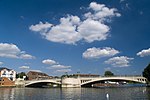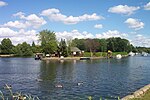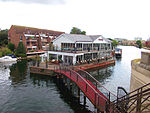West Memorial Hall
1866 establishments in EnglandAlfred Waterhouse buildingsChurches completed in 1866Churches in Reading, BerkshireFormer Baptist churches in England ... and 2 more
Grade II listed buildings in ReadingUse British English from February 2023

The West Memorial Hall, or West Memorial Institute, is a Victorian Grade II listed building at 7-9 Gosbrook Road, Caversham, Berkshire, designed by Alfred Waterhouse. The Hall is a former Baptist Free Church that has now been converted to apartments.
Excerpt from the Wikipedia article West Memorial Hall (License: CC BY-SA 3.0, Authors, Images).West Memorial Hall
Gosbrook Road, Reading Caversham
Geographical coordinates (GPS) Address Nearby Places Show on map
Geographical coordinates (GPS)
| Latitude | Longitude |
|---|---|
| N 51.46716 ° | E -0.97158 ° |
Address
Gosbrook Road 24
RG4 8BS Reading, Caversham
England, United Kingdom
Open on Google Maps







